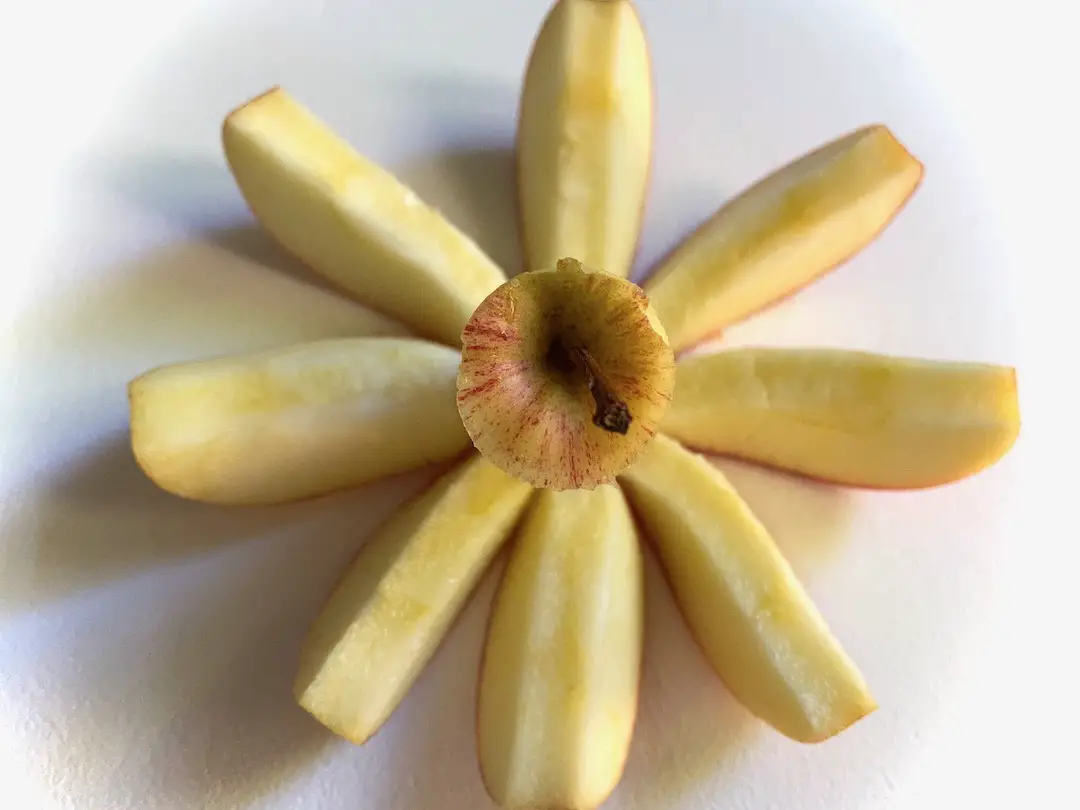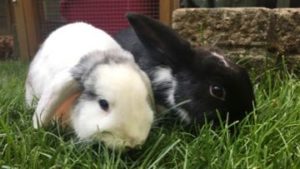Imagine a big pile of apples. Really big. Not just five, ten or twenty.
Imagine having over a hundred apples stacked up in front of you.
Would you give all of that in one go to your bunny?
Neither would I, or anyone. It’s far too much – the pile of apples would be much larger than the bunny.
Unless you are crazy enough to give over a hundred apples all at once to your bunny, giving apple to your rabbit friend is safe.
Rabbits can eat apples safely, including the core, pips (apple seeds) and stem. Apple is a great treat to feed rabbits. As with all fruit, the portion size should be small as too much of the sugar found in fruits is unhealthy. A portion size for a rabbit of 6lb (3kg) is about half of a small apple.
You might have come across a myth that apple cores and stems are dangerous for your bunnies.
Sites on the internet warn of all sorts of potential nasty symptoms and even death.
These sites are well-meaning, but not based on any science (and often just repeat the same warnings found on other sites).
Why is there a myth that apple seeds are dangerous to rabbits?
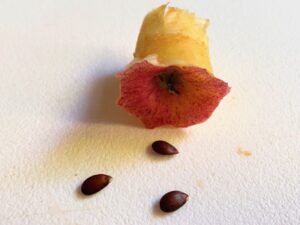
The myth that apple seeds are dangerous to bunnies has come about because they contain a substance that breaks down into cyanide.
Cyanide?! But that’s a deadly poison, isn’t it??
We react strongly and emotionally to this chemical, because it makes us think of James Bond, and spies, and deadly poison.
But quantities matter, and you need 144 apples to have seeds for the quantity of cyanide to be dangerous to a rabbit.
The Science – how dangerous are apple seeds to rabbits?
If you’ve ever bitten into an apple seed, you’ll know how sour and bitter it tastes.
That bitter taste is cyanide. (Yes – you’ve tasted cyanide and lived).
It comes from a chemical inside the seeds called amygdalin.
More formally, amygdalin is a cyanogenic glycoside. That’s a posh term for a chemical that breaks down, forming hydrogen cyanide as a result.
And hydrogen cyanide, in enough quantity, is dangerous. It can cause nausea, convulsions, heart problems and in extreme cases death.
To find out how many apples might be dangerous to a rabbit, we now need to find out three things:
- How many apple seeds in an apple
- How much amygdalin in an apple seed
- How much amygdalin is dangerous to a rabbit.
How many apple seeds in an apple
I’m going to use 8 apple seeds in an apple as a reasonable average.
Of course, each apple may vary (and each type of apple), but 8 is reasonable.
Each apple contains on average 8 apple seeds
How much amygdalin in an apple seed
Apple seeds contain, on average, 2.96 mg/g of amygdalin (research paper here). But apple seeds weigh less than a gram. On average, a typical apple seed weighs about 0.7g.
So each apple seed contains about 2.072mg of amygdalin.
How much amygdalin is dangerous to a rabbit
No-one (to my knowledge) has actually fed amygdalin to rabbits to find out what the lethal dose might be (thank goodness).
But scientists have done this with rats, who are similar enough to give us a good idea of what a lethal dose would be. (I’m glad I’m not this kind of scientist, but you can find the research paper here.)
For rats, the lethal dose of amygdalin is 880mg/kg. Let’s assume that it’s about the same for rabbits.
Now, bunnies come in all sorts of sizes, from Netherland Dwarfs through to Flemish Giants. Our bunnies, minilops, fall somewhere in the middle.
So I’m going to assume that the rabbit is about 4lb, or 2kg in weight.
This means that the lethal dose of amygdalin would be 1,760mg.
The maths
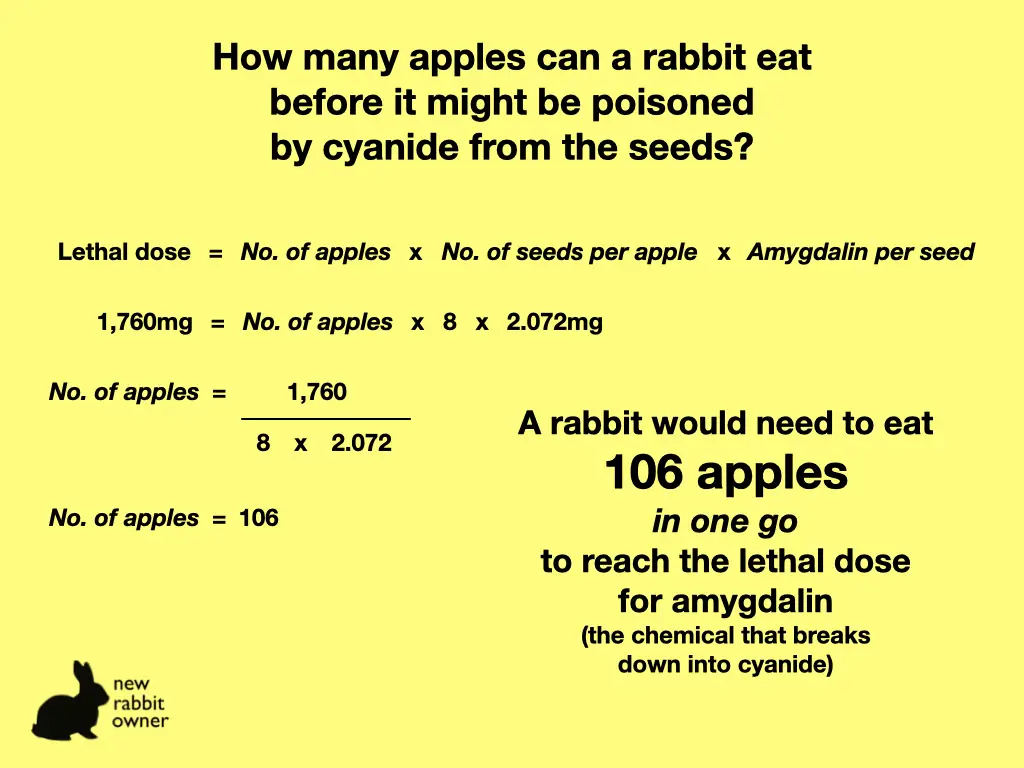
Number of apples to be dangerous = lethal dose / (apple seeds in apple x amygdalin in seed)
Number = 1,760/(8×2.072)
Number = 106.2
So you need to eat all the apple seeds from over a hundred apples to reach a lethal dose for an average bunny.
Can cyanide build up over time in a rabbit?
The short answer is, no. Cyanide is extremely reactive. While that makes it dangerous (in enough quantity), it also means that it breaks down quickly. Cyanide can’t build up inside the body.
But I heard that far fewer seeds were dangerous?
You may come across calculations that imply that far fewer seeds are dangerous for rabbits. These are based on the theoretical amount of cyanide that amygdalin could, in absolutely ideal lab conditions, produce. (A gram of amygdalin can theoretically produce 59mg of hydrogen cyanide).
And you can then carry out calculations based on lethal doses of hydrogen cyanide for rabbits (sadly, these experiments have been carried out – it’s 0.66mg/kg of bodyweight).
But this is much less useful or applicable than experiments carried out directly with amygdalin, which is the chemical actually found in the apple seeds.
Could an even higher number of apples be safe?
Short answer – yes.
I’ve taken an extremely conservative approach, by assuming that all the amygdalin in the apple seeds gets extracted by a rabbit.
But how often have you swallowed an apple seed by accident?
Apple seeds have evolved to be eaten. The hard, shiny, smooth shell is there so that it can pass intact through animals’ intestines to be left elsewhere. That’s how the seeds spread. And if it was dangerous to animals, it wouldn’t have succeeded.
In real life, very little amygdalin is likely to be released from the apple seeds. You would need to extract the apple seeds and grind them into fine powder to get anywhere close to the result I gave above (clearly – I don’t recommend you do this).
Are there any cases of rabbits being poisoned by apple seeds?
To the best of my knowledge, there are no known cases of rabbits being poisoned by apple seeds (not surprising, given the above).
And that’s not just me – it’s also the opinion of a vet who specialised in dealing with rabbits.
There are no reported cases of a rabbit dying from eating apple pips. In the autumn, wild rabbits feast on windfalls, including the pips, with no ill effects.
Frances Harcourt-Brown FRCVS, author of Textbook of Rabbit Medicine, European and RCVS Recognised Specialist in Rabbit Medicine and Surgery
How do apples fit into a rabbit’s diet?
| Ingredient | Nutrional value per 100g | Comments |
|---|---|---|
| Water | 85.6g | Apples have a lot of water in them. This is helpful on hot days for bunnies. |
| Energy | 52 kcal | This is mostly from the fruit sugars, which are types of carbohydrates. Like most sweet things, too much is bad for you. |
| Fibre | 2.4g | Rabbits need a lot of fibre – hay, which is best for them, is nearly 20% fibre. So apples on their own don’t provide enough. Much of the fibre is in the skin, so don’t peel the apple to give to your bunny,. |
| Carboydrates | 13.8g | Much of this are sugars – see the next entry. |
| Sugars | 10.4g | Half of the sugar is fructose, the rest sucrose and glucose. The sugar content is why apples taste sweet to us (and to our furry friends). |
| Vitamin C (ascorbic acid) | 4.6mg | Rabbits don’t need vitamin C – their bodies can make it themselves. |
| Vitamin B complex | Small amounts | Rabbits don’t need vitamin B – their bodies can make it themselves. |
| Vitamin A | 54 IU | Apples provide a little vitamin A for rabbits, but they need far more (6-10,000 IU daily). |
| Vitamin E, D & K | Small amounts | The amounts of these vitamins is not significant for bunnies. |
| Calcium, Iron, Magnesium, Phosphorus, Zinc, Copper, Potassium, Sodium, Manganese, Selenium | Low | Apples don’t provide significant amounts of any of these minerals for rabbits |
Apples make a great treat for rabbits. But the bulk of their diet should always be hay (see our post on Timothy hay for more information on why this is the best food).
Check out the nutritional table above. Apples on their own don’t provide enough fibre, minerals or vitamins for rabbits. That’s why rabbits need lots of hay, and to have apple as a treat.
It’s best if bunnies have unlimited access to hay.
You can also give rabbits a handful of greens a day, and a small amount of nuggets a day (about an eggcup).
Always make sure that your bunny has plenty of water to drink.
Don’t give too much apple to your pet bunny – not because of any worries about the seeds, but because apples, like most fruit, contain fruit sugars.
This is why apples taste sweet. They contain fructose, and in lesser amounts glucose and sucrose.
Just as too much sugar is bad for us humans, too much sugar is bad for rabbits.
That’s why apples should be a treat, and portion size controlled for your bunny.
A suitable portion size is about half a small apple for a medium sized rabbit.
You can find more about rabbit nutrition here, and more about how rabbits digest food here.
Can rabbits eat apple skin?
Rabbits can eat the skin on apples (and it’s good for them – extra fibre).
Can rabbits eat apple leaves or twigs?
Rabbits can safely gnaw away at apple leaves and twigs. This will also help their teeth – rabbits’ teeth never stop growing, so bunnies need to chew away on rough food to keep their teeth to a healthy length.
Conclusion – can rabbits eat apples?
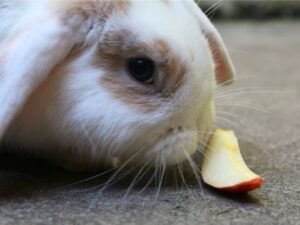
Rabbits can eat all parts of an apple safely. Don’t believe myths about apple seeds that are not based on science.
You can check out what other fruit are safe for rabbits to eat at our comprehensive post covering this.
We also have an article checking out which herbs are OK to give your bunny.
If you’re worried about your rabbit’s health, make sure that you have insurance so you can cover any vet bills. For UK readers, I did a comparison of the pet rabbit insurance providers.
And if you want to keep your bunnies entertained, check out our favourite toys for rabbits.

